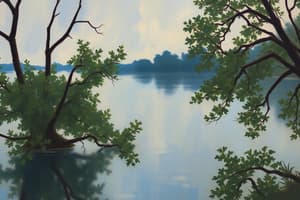Podcast
Questions and Answers
Which type of line can suggest texture in a work of art?
Which type of line can suggest texture in a work of art?
- Diagonal line
- Curved line
- Horizontal line
- All types of lines (correct)
Which shape is considered geometric?
Which shape is considered geometric?
- A splash of paint
- A circle (correct)
- A cloud
- A silhouette of a tree
What does value in art refer to?
What does value in art refer to?
- The amount of detail in an image
- The lightness or darkness of a color (correct)
- The frequency of colors used
- The presence of only black and white colors
How can form be described in art?
How can form be described in art?
What is the role of texture in an artwork?
What is the role of texture in an artwork?
Which of the following is NOT a characteristic of shape?
Which of the following is NOT a characteristic of shape?
What effect can the use of varying values in art create?
What effect can the use of varying values in art create?
Which option best describes organic shapes?
Which option best describes organic shapes?
What is a characteristic of both visual and tactile texture?
What is a characteristic of both visual and tactile texture?
How can lines help in creating movement within an artwork?
How can lines help in creating movement within an artwork?
Flashcards are hidden until you start studying
Study Notes
Elements of Art
The elements of art are the fundamental building blocks used to create a work of art.
Line
- A continuous mark made on a surface by a drawing tool
- Can vary in:
- Direction (horizontal, vertical, diagonal, curved)
- Length (short, long)
- Width (thick, thin)
- Texture ( rough, smooth)
- Curvature (straight, curved, angular)
- Can be used to:
- Define shape and form
- Create movement and energy
- Suggest texture and pattern
- Create depth and perspective
Shape
- A self-contained area with height, width, and depth
- Can be:
- Geometric (e.g. square, circle, triangle)
- Organic (e.g. free-form, natural)
- Positive (actual shape) or negative (space around shape)
- Can be used to:
- Create form and structure
- Suggest volume and mass
- Create pattern and rhythm
- Convey emotion and mood
Value
- The lightness or darkness of a color
- Ranges from pure black to pure white
- Can be used to:
- Create contrast and emphasis
- Suggest volume and three-dimensionality
- Create mood and atmosphere
- Guide the viewer's eye through the composition
Form
- A three-dimensional volume created by lines, shapes, and values
- Can be:
- Geometric (e.g. cube, sphere)
- Organic (e.g. natural, free-form)
- Abstract (non-representational)
- Can be used to:
- Create volume and mass
- Suggest texture and structure
- Create movement and energy
- Convey emotion and meaning
Texture
- The surface quality of an artwork
- Can be:
- Visual (created through illusion)
- Tactile (actual physical texture)
- Can be used to:
- Create sensory experience
- Suggest materiality and authenticity
- Add depth and interest to a composition
- Convey emotion and mood
Elements of Art
Line
- A continuous mark made on a surface by a drawing tool with varying characteristics:
- Direction (horizontal, vertical, diagonal, curved)
- Length (short, long)
- Width (thick, thin)
- Texture (rough, smooth)
- Curvature (straight, curved, angular)
- Used to define shape and form, create movement and energy, suggest texture and pattern, and create depth and perspective.
Shape
- A self-contained area with height, width, and depth, classified as:
- Geometric (e.g.square, circle, triangle)
- Organic (e.g.free-form, natural)
- Positive (actual shape) or negative (space around shape)
- Used to create form and structure, suggest volume and mass, create pattern and rhythm, and convey emotion and mood.
Value
- The lightness or darkness of a color, ranging from pure black to pure white.
- Used to create contrast and emphasis, suggest volume and three-dimensionality, create mood and atmosphere, and guide the viewer's eye through the composition.
Form
- A three-dimensional volume created by lines, shapes, and values, classified as:
- Geometric (e.g.cube, sphere)
- Organic (e.g.natural, free-form)
- Abstract (non-representational)
- Used to create volume and mass, suggest texture and structure, create movement and energy, and convey emotion and meaning.
Texture
- The surface quality of an artwork, classified as:
- Visual (created through illusion)
- Tactile (actual physical texture)
- Used to create a sensory experience, suggest materiality and authenticity, add depth and interest to a composition, and convey emotion and mood.
Studying That Suits You
Use AI to generate personalized quizzes and flashcards to suit your learning preferences.




